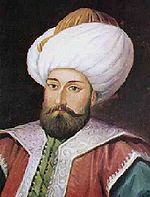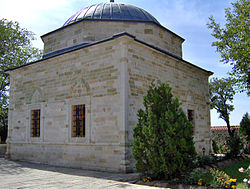- Murad I
-
 Murad I
Murad IOttoman Sultan 
Reign 1362–1389 Period Rise of the Ottoman Empire Predecessor Orhan I Successor Bayezid I Royal House House of Osman Dynasty Ottoman Dynasty Murad I (nicknamed Hüdavendigâr - "the Emperor") (Serbian: Мурат 1. / Murat I) (Turkish: I. Murat Hüdavendigâr) (March or June 29, 1326, Sogut or Bursa – June 15, 1389, Battle of Kosovo Polje) (Ottoman Turkish: مراد اول) was the Sultan of the Ottoman Empire, from 1361 to 1389. He was the son of Orhan I and the Valide Sultan Nilüfer Hatun and became the ruler following his father's death in 1361.
Contents
Establishment of Empire
He established the Empire by building up a society and government in the newly conquered city of Adrianople (Edirne in Turkish) and by expanding the realm in Europe, bringing most of the Balkans under Ottoman rule and forcing the Byzantine emperor to pay him tribute. It was Murad who established the former Osmanli tribe into an empire. He established the title of sultan in 1383 and the corps of the janissaries and the devşirme recruiting system. He also organised the government of the Divan, the system of timars and timar-holders (timariots) and the military judge, the kazasker. He also established the two provinces of Anadolu (Anatolia) and Rumeli (Europe).
Wars
Murad fought against the powerful emirate of Karaman in Anatolia and against the Serbs, Bulgarians and Hungarians in Europe. In particular, a Serb expedition to expel the Turks from Adrianople led by the Serbian brothers King Vukašin and Despot Uglješa, was defeated on September 26, 1371, by Murad's Murat capable second lieutenant Lala Şâhin Paşa, the first governor (beylerbey) of Rumeli. In 1385 Sofia fell to the Ottomans. In 1386 Despot Lazar Hrebeljanović defeated an Ottoman force at the Battle of Pločnik. The Ottoman army suffered heavy casualties, and was unable to capture Niš on the way back. In 1389 Murad's army defeated the Serbian Army and its allies under the leadership of Lazar at the Battle of Kosovo.
There are different accounts from different sources about when and how Murad I was assassinated. The contemporary sources mainly noted that the battle took place and that both Prince Lazar and the Sultan lost their lives in the battle. The existing evidence of the additional stories and speculations as to how Murad I died were disseminated and recorded in the 15th century and later, decades after the actual event. One Western source states that during first hours of the battle, Murad I was assassinated by Serbian nobleman and knight Miloš Obilić by knife.[1][2] Most Ottoman chroniclers (including Dimitrie Cantemir) [3] state that he was assassinated after the finish of the battle while going around the battlefield. Others state that he was assassinated in the evening after the battle at his tent by the assassin who was admitted to ask a special favour. His older son Bayezid, who was in charge of the left wing of the Ottoman forces, took charge after that. His other son, Yakub Bey, who was in charge of the other wing, was called to the Sultan's command center tent by Bayezid, but when Yakub Bey arrived he was strangled, leaving Bayezid as the sole claimant to the throne.
In the earliest preserved Christian record[citation needed], a letter of Florentine senate to the King Tvrtko I of Bosnia, dated 20 October 1389, Murad I's killing was described. A warrior had managed to get through the Ottoman army and kill Murad I.
Sultan Murad's internal organs were buried in Kosovo field and remains to this day on a corner of the battlefield in a location called Meshed-i Hudavendigar which has gained a religious significance by the Muslims (which had been renamed Obilić by the Serbs). It has recently been renovated. His other remains were carried to Bursa, his Anatolian capital city, and were buried in a tomb at the complex built in his name.
Marriages and progeny
 Murad I
Murad I
He was the son of Orhan I and the Valide Sultan Nilüfer Hatun, daughter of the Prince of Yarhisar or Byzantine princess Theodora Kantakouzene (also named Nilüfer), who was of ethnic Greek descent[4][5][6]
Marriages of Murad I:
- In 1359 Valide Sultan Gülçiçek Hatun – of Greek origin
- In 1370 Maria Thamara Hatun – sister of Bulgarian Czar Ivan Shishman
- Pasha Melek Hatun – daughter of Kizil Murad Bey
- Fulane Hatun – daughter of Jandarids
Progeny of Murad I:
- Yakub Celebi (? - d. 1389) - son. In the first recorded fratricide in the history of the Ottoman dynasty, Bayezid I had Yakub killed during or following the Battle of Kosovo at which their father had been killed.
- Sultan Bayezid I (1354–1402)- son of Gulcicek Hatun
- Savcı Bey - son. He and his lover, Byzantyne emperor John V Palaeologus' son Andronicus,[7] rebelled against their fathers. Murad had Savci killed. Andronicus, who had surrendered to his father, was imprisoned and blinded at Murad's insistence.[8]
- Ibrahim Bey - son
- Yahshi Bey - son of Gulcicek Hatun
- Halil Bey - son
- Nefise - daughter
- Sultan - daughter
Sultan Murad in literature
- In William Shakespeare's history play Henry V, Prince Harry refers to Murad as "Amurath" in Act V Scene 2 when he succeeds his father, King Henry IV, in 1412:
- Chief Justice. Good morrow, and God save your majesty!
- King Henry V. This new and gorgeous garment, majesty,
- Sits not so easy on me as you think.
- Brothers, you mix your sadness with some fear:
- This is the English, not the Turkish court;
- Not Amurath an Amurath succeeds,
- But Harry Harry!
- Murad (as "Amurath the First") is the subject of Thomas Goffe's play The Courageous Turk, published in 1632.
Further reading
- Harris, Jonathan, The End of Byzantium. New Haven and London: Yale University Press, 2010. ISBN 978 0 30011786 8
- Imber, Colin, The Ottoman Empire. London: Palgrave/Macmillan, 2002. ISBN 0 333 613872
References
- ^ Helmolt, Ferdinand. The World's History, p.293. W. Heinemann, 1907.
- ^ Fine, John. The Late Medieval Balkans, p.410. University of Michigan Press, 1994. ISBN 0472082604.
- ^ Cantemir, Dimitrie, History of the Growth and Decay of the Osman Ottoman Empire, London 1734.
- ^ The Fall of Constantinople, Steven Runciman, Cambridge University Press, p.36
- ^ The Nature of the Early Ottoman State, Heath W. Lowry, 2003 SUNY Press, p.153
- ^ History of the Ottoman Empire and Modern Turkey, Stanford Jay Shaw, Cambridge University Press, p.24
- ^ Gibbon, Edward, Decline and Fall of the Roman Empire, Modern Library, v. iii, p. 651
- ^ Finkel, C., Osman's Dream: The History of the Ottoman Empire, 2005, pp.19, Basic Books
Murad IBorn: 1319 Died: 1389Regnal titles Preceded by
Orhan ISultan of the Ottoman Empire
1362–1389Succeeded by
Bayezid IOttoman Sultans / Caliphs Osman I · Orhan · Murad I · Bayezid I · Interregnum · Mehmed I · Murad II · Mehmed II · Murad II · Mehmed II · Bayezid II · Selim I · Suleiman I · Selim II · Murad III · Mehmed III · Ahmed I · Mustafa I · Osman II · Mustafa I · Murad IV · Ibrahim · Mehmed IV · Suleiman II · Ahmed II · Mustafa II · Ahmed III · Mahmud I · Osman III · Mustafa III · Abdülhamid I · Selim III · Mustafa IV · Mahmud II · Abdülmecid I · Abdülaziz · Murad V · Abdülhamid II · Mehmed V · Mehmed VI · Abdülmecid II (Caliph)Related Templates: Claimants · Valide SultansCategories:- Monarchs killed in action
- Murdered monarchs
- 14th-century births
- 1389 deaths
- Characters in Serbian epic poetry
- 14th-century Ottoman sultans
- Assassinated Ottoman people
Wikimedia Foundation. 2010.


